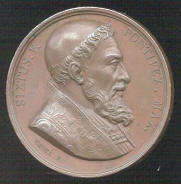 Few
popes have so captured the imagination as Gregory's successor, the Minorite
Conventual Felice Peretti who took the name Sixtus V. A vigorous sixty-four on
his election, with sharp eyes gleaming from under bushy brows, Sixtus ruled the
Church with intelligence and vigor.
Few
popes have so captured the imagination as Gregory's successor, the Minorite
Conventual Felice Peretti who took the name Sixtus V. A vigorous sixty-four on
his election, with sharp eyes gleaming from under bushy brows, Sixtus ruled the
Church with intelligence and vigor.
Felice Peretti was born December 13, 1521, at Grottamare of poor parents. He did
the usual chores of a peasant lad until a Franciscan uncle sent him to the
Conventual friary at Montalto to get an education. Felice loved the friars and
soon entered the order. He became a learned theologian and an eloquent preacher.
In 1552 he preached the Lent in Rome and gained the friendship of such reform
leaders as Cardinals Caraffa and Ghislieri, St. Ignatius and St. Philip Neri.
Though his severity as an inquisitor at Venice led to his recall, his rise in
the hierarchy was rapid. Procurator- general of the Franciscans, bishop and
cardinal, he was confessor to St. Pius V. But Gregory XIII had little use for
him, and during Gregory's reign, Felice devoted himself to scholarly pursuits.
In spite of his absence from the center of power he was quickly elected to
succeed Gregory on April 24, 1585. Sixtus proved to be both a good king and a
good pope. He fearlessly grappled with the bandit problem which had plagued so
many popes. First, he secured extradition treaties with neighboring states, then
he pursued the criminals with ruthless severity. The knowledge that neither
noble blood nor powerful protectors could shield rascals from the noose or the
ax made robbery a less popular pastime in the Papal States. Horrified at the
state of papal finances, Sixtus by new taxes, by increasing the number of
salable offices, and by other devices, managed to amass a huge treasure in
Castle of St. Angelo, while at the same time he spent much on public works. He
finally got the dome of St. Peter's finished, built a new Lateran Palace,
erected four obelisks and a large aqueduct to bring water for Rome's many
fountains.
Keenly interested in the welfare of the poor, he planned to drain the Pontine
Marshes and strove to keep the price of bread low. Sixtus V might be called the
great organizer of the papacy in modern times. With lucidity and vigor he so
efficiently reorganized the papal curia that essentially his system still
prevails. He grouped the cardinals into fifteen congregations, each of which
assisted the pope in a special phase of Church business. The number of cardinals
he limited to seventy. Sixtus also restored the custom that bishops should visit
Rome at regular intervals. Sixtus admired Elizabeth of England and longed for
her return to the old faith, but the execution of Mary Stuart did much to
disillusion him, and he helped Philip send his anything but invincible armada
against Elizabeth. He was, however, no court chaplain to Philip. In France where
the murder of Henry III had left the throne open to Huguenot Henry of Navarre,
the Pope, though at first hostile to Navarre, adopted a cautious policy which
disgusted the Spaniards but paid dividends later. Sixtus V died August 27, 1590.
One of his last acts was to take half a million ducats from his St. Angelo
treasury to help the poor during a bad harvest.
Excerpted from "Popes
Through the Ages" by Joseph Brusher, S.J.

